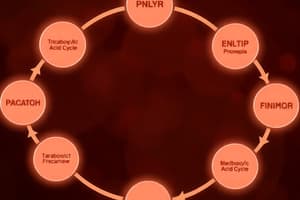Podcast
Questions and Answers
What is the aim of the slide set?
What is the aim of the slide set?
- To show a real BPD struggle in action (correct)
- To provide an overview of BPD
- To explain how to manage emotions
- To teach about cognitive distortions
What do the bubbles in the slide represent?
What do the bubbles in the slide represent?
- The common types of unhealthy thoughts
- The different stages of BPD
- The different types of cognitive distortions
- The order of events, interpretations, emotions, self-talk, and new events (correct)
What does the slide help understand?
What does the slide help understand?
- How to manage emotions
- How to diagnose BPD
- How to identify cognitive distortions
- How different parts of a BPD experience connect (correct)
What does the slide portray?
What does the slide portray?
What do the letters 'CD' in the flowchart indicate?
What do the letters 'CD' in the flowchart indicate?
What happens when thoughts and feelings are not mindfully observed?
What happens when thoughts and feelings are not mindfully observed?
What could happen when two or more people follow this pattern of not noticing or managing 'their stuff' internally?
What could happen when two or more people follow this pattern of not noticing or managing 'their stuff' internally?
What must those who suffer from BPD become proficient at?
What must those who suffer from BPD become proficient at?
What becomes easier when attending to feelings mindfully?
What becomes easier when attending to feelings mindfully?
What will empower a person to adjust unhealthy thoughts, emotions, and behaviours?
What will empower a person to adjust unhealthy thoughts, emotions, and behaviours?
What becomes possible when a person adjusts their self-talk and interpretation?
What becomes possible when a person adjusts their self-talk and interpretation?
Why is life more challenging for those with untreated BPD?
Why is life more challenging for those with untreated BPD?
What is the aim of the slide set?
What is the aim of the slide set?
What do the bubbles in the slide represent?
What do the bubbles in the slide represent?
What does the slide help understand?
What does the slide help understand?
What does the slide portray?
What does the slide portray?
What do the letters 'CD' in the flowchart indicate?
What do the letters 'CD' in the flowchart indicate?
What happens when thoughts and feelings are not mindfully observed?
What happens when thoughts and feelings are not mindfully observed?
What could happen when two or more people follow this pattern of not noticing or managing 'their stuff' internally?
What could happen when two or more people follow this pattern of not noticing or managing 'their stuff' internally?
What must those who suffer from BPD become proficient at?
What must those who suffer from BPD become proficient at?
What becomes easier when attending to feelings mindfully?
What becomes easier when attending to feelings mindfully?
What will empower a person to adjust unhealthy thoughts, emotions, and behaviours?
What will empower a person to adjust unhealthy thoughts, emotions, and behaviours?
What becomes possible when a person adjusts their self-talk and interpretation?
What becomes possible when a person adjusts their self-talk and interpretation?
Why is life more challenging for those with untreated BPD?
Why is life more challenging for those with untreated BPD?
What is the purpose of the slide set?
What is the purpose of the slide set?
What do the bubbles in the slide correspond to?
What do the bubbles in the slide correspond to?
What does the slide show about BPD struggles?
What does the slide show about BPD struggles?
What are cognitive distortions?
What are cognitive distortions?
What can happen if thoughts and feelings are not mindfully observed?
What can happen if thoughts and feelings are not mindfully observed?
What can toxic interactions between people result in?
What can toxic interactions between people result in?
What is one challenge faced by those who suffer from BPD?
What is one challenge faced by those who suffer from BPD?
What becomes easier when attending to feelings mindfully?
What becomes easier when attending to feelings mindfully?
What does practicing empathy for the emotional experience of yourself and others empower you to do?
What does practicing empathy for the emotional experience of yourself and others empower you to do?
What can adjusting unhealthy thoughts and emotions result in?
What can adjusting unhealthy thoughts and emotions result in?
What makes life more challenging for those with untreated BPD?
What makes life more challenging for those with untreated BPD?
What is the main benefit of becoming proficient at managing emotions for those with BPD?
What is the main benefit of becoming proficient at managing emotions for those with BPD?
Flashcards are hidden until you start studying
Study Notes
Understanding Borderline Personality Disorder and Managing Emotions
- The slide set aims to bring together the learning from previous steps and show a real Borderline Personality Disorder (BPD) struggle in action.
- The bubbles in the slide correspond to the teachings from Step 3 (slide set 4) and show the order of events, interpretations, emotions, self-talk, and new events.
- The process helps understand how these parts of a BPD experience connect and make for a messy situation.
- The slide portrays the raw emotions and thoughts that can happen during a BPD struggle, those not well-managed before a person has developed sufficient self-awareness and skill to self-adjust.
- The slide identifies the common types of unhealthy thoughts (cognitive distortions) that can be part of these moments, as indicated by "CD" in the flowchart.
- The slide shows how not mindfully observing thoughts and feelings can make things increasingly ineffective, resulting in unhealthy thoughts and intense emotions co-occurring.
- When two or more people follow this pattern of not noticing or managing “their stuff” internally, interactions could become toxic, resulting in rejection, isolation, and self-destructive behaviour.
- Those who suffer from BPD tend to have more intense emotional challenges and must become proficient at managing them.
- Attending to feelings mindfully becomes easier to settle feelings, enjoy constructive conversations with others, and recall essential information while conversing.
- Learning to love your raw emotional experience and practicing empathy for the emotional experience of yourself and others will empower you to adjust unhealthy thoughts, emotions, and behaviours.
- The way things get worded in the new self-talk and interpretation, it becomes possible to let go of unnecessary and toxic emotions such as guilt, shame, worthlessness, and fear.
- When a person has untreated Borderline Personality Disorder, life tends to be much more challenging because of the additional “heavy” emotions that aren’t dealt with effectively.
Understanding Borderline Personality Disorder and Managing Emotions
- The slide set aims to bring together the learning from previous steps and show a real Borderline Personality Disorder (BPD) struggle in action.
- The bubbles in the slide correspond to the teachings from Step 3 (slide set 4) and show the order of events, interpretations, emotions, self-talk, and new events.
- The process helps understand how these parts of a BPD experience connect and make for a messy situation.
- The slide portrays the raw emotions and thoughts that can happen during a BPD struggle, those not well-managed before a person has developed sufficient self-awareness and skill to self-adjust.
- The slide identifies the common types of unhealthy thoughts (cognitive distortions) that can be part of these moments, as indicated by "CD" in the flowchart.
- The slide shows how not mindfully observing thoughts and feelings can make things increasingly ineffective, resulting in unhealthy thoughts and intense emotions co-occurring.
- When two or more people follow this pattern of not noticing or managing “their stuff” internally, interactions could become toxic, resulting in rejection, isolation, and self-destructive behaviour.
- Those who suffer from BPD tend to have more intense emotional challenges and must become proficient at managing them.
- Attending to feelings mindfully becomes easier to settle feelings, enjoy constructive conversations with others, and recall essential information while conversing.
- Learning to love your raw emotional experience and practicing empathy for the emotional experience of yourself and others will empower you to adjust unhealthy thoughts, emotions, and behaviours.
- The way things get worded in the new self-talk and interpretation, it becomes possible to let go of unnecessary and toxic emotions such as guilt, shame, worthlessness, and fear.
- When a person has untreated Borderline Personality Disorder, life tends to be much more challenging because of the additional “heavy” emotions that aren’t dealt with effectively.
Understanding Borderline Personality Disorder and Managing Emotions
- The slide set aims to bring together the learning from previous steps and show a real Borderline Personality Disorder (BPD) struggle in action.
- The bubbles in the slide correspond to the teachings from Step 3 (slide set 4) and show the order of events, interpretations, emotions, self-talk, and new events.
- The process helps understand how these parts of a BPD experience connect and make for a messy situation.
- The slide portrays the raw emotions and thoughts that can happen during a BPD struggle, those not well-managed before a person has developed sufficient self-awareness and skill to self-adjust.
- The slide identifies the common types of unhealthy thoughts (cognitive distortions) that can be part of these moments, as indicated by "CD" in the flowchart.
- The slide shows how not mindfully observing thoughts and feelings can make things increasingly ineffective, resulting in unhealthy thoughts and intense emotions co-occurring.
- When two or more people follow this pattern of not noticing or managing “their stuff” internally, interactions could become toxic, resulting in rejection, isolation, and self-destructive behaviour.
- Those who suffer from BPD tend to have more intense emotional challenges and must become proficient at managing them.
- Attending to feelings mindfully becomes easier to settle feelings, enjoy constructive conversations with others, and recall essential information while conversing.
- Learning to love your raw emotional experience and practicing empathy for the emotional experience of yourself and others will empower you to adjust unhealthy thoughts, emotions, and behaviours.
- The way things get worded in the new self-talk and interpretation, it becomes possible to let go of unnecessary and toxic emotions such as guilt, shame, worthlessness, and fear.
- When a person has untreated Borderline Personality Disorder, life tends to be much more challenging because of the additional “heavy” emotions that aren’t dealt with effectively.
Studying That Suits You
Use AI to generate personalized quizzes and flashcards to suit your learning preferences.




